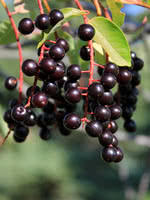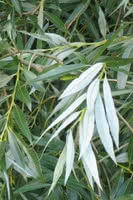Mon-Fri 9am - 5pm Mountain time
Western Chokecherry vs Silver Leaf Willow
Prunus virginiana var. demissa
Salix alba sericea
NOT AVAILABLE THIS SEASON - MIGHT RETURN
NOT AVAILABLE THIS SEASON - MIGHT RETURN
Western Chokecherry is a shrub or small tree commonly used for farmstead and field windbreaks.
It produces white flowers in the spring and edible dark purple fruit that matures between September and October. Its cherries are great for making for making jams, jellies or wine, but are not very palatable for raw eating.
Native to North America, Silver Leaf Willow has orangish bark and long, silvery grey leaves. Bees and other insects are attracted to its flowers.
Popular as an ornamental tree for parks, it is also used as a shelterbelt species. It may not be as cold hardy as some of the other willow varieties, however.
Western Chokecherry Quick Facts
Silver Leaf Willow Quick Facts
Toxicity: toxic to horses, cattle, etc.)

